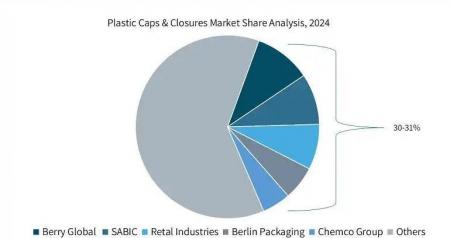The plastic caps and closures market is on track for significant growth, rising from about USD 52.1 billion in 2024 to approximately USD 84.9 billion by 2032, at a CAGR of 6.4%, propelled by packaging innovation, rising beverage demand, and eco-driven solutions.
Plastic Caps and Closures Market
Request a sample copy of the research report: https://www.datamintelligence.com/download-sample/plastic-caps-and-closures-market
Market Overview & Key Drivers
- Strong Market Growth
The market reached USD 49.4B in 2023, climbed to USD 52.06B in 2024, and is forecast to hit USD 84.87B by 2032 at 6.4% CAGR. - Food & Beverage Demand
Beverages dominate end-use with over 41% share, while food (25.6%) and healthcare (18.9%) markets drive demand for resealable, sanitary, child-resistant closures. - Packaging Innovation
Screw-on caps lead in reliability; dispensing and child-resistant closures are the fastest-growing. Post-mould tamper-evident (TE) bands now grow over 6% CAGR, offering enhanced security. - Sustainability & Regulations
Rising consumer and regulatory expectations are pushing recyclable PP/PE materials (55.8% of cap materials), lightweight design, and PET bottle caps made with fully recyclable resin.
Market Segmentation & Innovation
By Product Type
- Screw caps hold the largest share due to widespread use.
- Dispensing closures see fastest growth driven by the need for controlled output in pharma and personal care.
By Technology
- Post-mould TE bands are the top growth area at over 6% CAGR, providing tamper evidence and design flexibility.
- Injection moulding remains dominant for precision closures.
By Material
- Plastics dominate with 55.8% market share.
- Metals account for 30.4%, mostly in premium spirits, while glass, rubber, and composites make up the remaining 13.8%.
Regional Spotlight: U.S. & Japan
?? United States
- Market Dynamics
North America is mature, with innovators like Amcor, Silgan, and Aptar leading eco-friendly, smart closures; U.S. market projected to grow at ~4.5% CAGR. - Trending Innovation
In 2024, Origin Materials and Reed City Group launched PET caps lines using recycled resin, paving way for sustainable packaging.
?? Japan
- Market Expansion
Asia-Pacific leads overall, with Japan showing strong growth due to demand in bottled beverages, cosmetics, and pharma. - Eco & Tech Focus
Japanese manufacturers prioritize recyclable closures and lightweight designs to meet strict environmental standards and consumer expectations.
Growth Opportunities
- Eco‑friendly Materials & Circular Packaging
Growth in rPET and CaPET resin caps supports recyclability and waste reduction. - Smart & Tamper‑Evident Technology
Tamper bands and sensor-embedded closures bring added security, especially in pharma and beverages. - Convenient and Functional Caps
Dispensing, child-resistant, and sports caps see rising demand in personal care and health products. - Lightweight & Cost‑Effective Design
Minimizing material use reduces cost and environmental impact, meeting regulatory goals. - Regional Manufacturing Growth
Expansion in Asia–Pacific, led by China, India, Japan, driven by rising packaged goods consumption.
Challenges
- Raw-Resin Price Volatility
Fluctuating PP/PE prices push margins and pricing uncertainty. - Regulations & Plastic Waste Bans
Bans or taxes on single-use plastics challenge producers to pivot to recyclables. - Competition from Metal/Glass
A preference for premium closure materials in high-end markets may shrink plastic share.
Expert Insight
“Innovations like rPET caps and TE bands are reshaping packaging by aligning convenience with sustainability,” observes GM Insights.
“Post-mould tamper-evident technology offers flexibility and added value, making closures more than just seals,” notes Grand View Research.
Request a Quotation: https://www.datamintelligence.com/buy-now-page?report=plastic-caps-and-closures-market
Strategic Takeaways
- Producers should invest in recyclables, sensor tech, and lightweight moulding solutions.
- Brands need to adopt closures that meet eco and security requirements while enhancing consumer convenience.
- Regulators should incentivise recyclable materials and standardise tamper-evident certification.
- Investors can capitalise on growth in eco-tech closures, Asia-Pacific expansion, and smart-cap innovations.










留言 (0)